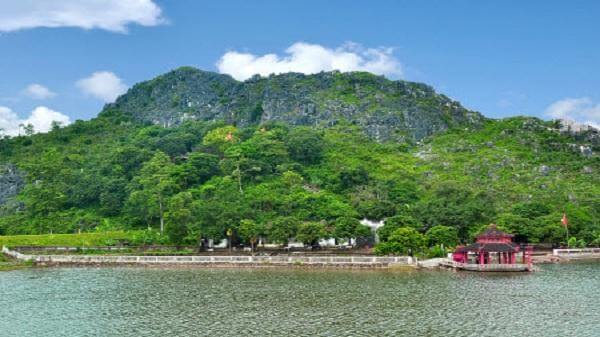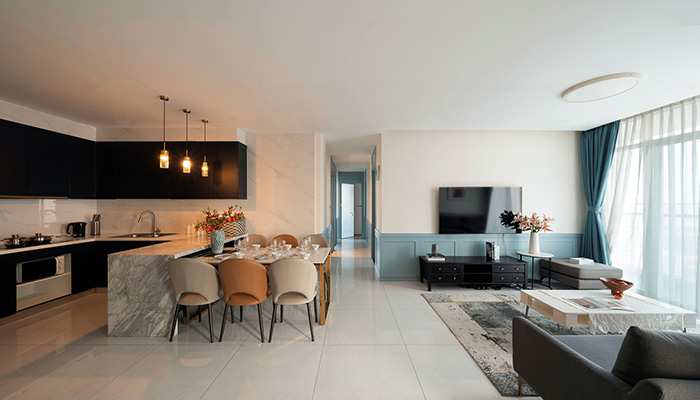A long-standing and famous historical site in Ha Nam
In Ha Nam, historical relics have long become cultural symbols and tourist attractions of this land. With the magic of time and historical beauty, these places are not only a destination for those curious about the past but also a place to understand the contributions and cultural quintessence of the nation.

Doi Son Pagoda, a spiritual destination in Ha Nam, about 50km south of Hanoi centre. Located on the sacred Doi Mountain shaped like a dragon, the pagoda is also known as Dien Linh Tu or Long Doi Son Pagoda. With its back against Diep Mountain and surrounding three rivers, Doi Son Pagoda creates a peaceful space and mysterious nature. To get to the temple, you have to climb nearly 400 stone steps in the cool shade of trees, creating a meaningful spiritual journey. Doi Son Pagoda Festival and Doi Son Tich Dien Festival attract a large number of tourists and devotees to participate, highlighting the natural beauty and spirit of the land of Ha Nam. Long Doi Son Pagoda, built in 1054 under the chairmanship of King Ly Thanh Tong and Vuong Phi Y Lan, is a historical spiritual work. In 1121, King Ly Nhan Tong continued to embellish and build the Sung Thien Dien Linh stupa. By the early 15th century, when the Ming invaders invaded, the pagoda faced waves of destruction. Beginning in 1591, local people organised work to repair and restore the temple. During the resistance war against the French, the pagoda once again faced heavy destruction. Since the 2000s, the pagoda has continued the process of renovation and embellishment to preserve and promote the historical and cultural value of this monument. Doi Son Pagoda has spacious architecture on a large area of about 10,000 square metres. With works such as the main hall, Tam Quan building, human chess board, Mau palace, stele house, Tam Bao building and rear palace, the pagoda bears the mark of traditional architecture of the Ly Dynasty. The three-entrance gate with moss-coloured walls creates a solemn look, and the Sung Thien Dien Linh stele records the history and culture of the pagoda. The main part faces south, with a 50m2 human chess board. The corridor with 10 prison doors reminds of the values of truth, goodness and beauty. The Three Jewels Court and the pagoda's back hall worship Buddha and important historical figures. The sub-area on the left has 5 compartments of the Patriarch's house, a lecture hall, a guest house, a kitchen, and a monk's room. To the west is the tower garden from the Nguyen Dynasty, and to the right is the Mother Palace, adding sacredness to the surrounding space. Long Doi Son Pagoda owns a number of relics over 1000 years old such as: Sung Thien Dien Linh stele, Diamond Statue, Bird body statue.

In addition, Bat Canh Son, a complex of scenic relics, located in Tuong Linh commune, Kim Bang district, Ha Nam, is also a unique natural masterpiece. Located on the banks of the Day River and near the Nam Cong arc, Bat Canh Son creates a unique and attractive world of mountains and rivers. This famous tourist destination is also part of the Huong Son complex, closely adjacent to each other. The geographical location of Bat Canh Son at the intersection of three districts: Kim Bang (Ha Nam), My Duc and Ung Hoa (Hanoi) is like a gate opening to the world of Huong Son. In Bat Canh Son, visitors can visit Tien Ong Temple, a spiritual architectural masterpiece from the reign of King Tran Nhan Tong. This temple stands proudly on top of Tuong Linh mountain, about 200m high, has a unique triangle-shaped architecture and preserves many important historical relics. This place is also the place to worship the Great Tutelary God of Heavenly Patriarch Thien Vuong Bodhisattva and has passed down many mysterious stories. On the full moon day of June every year, the festival honouring the Fairy Gods attracts a large number of tourists to attend. Ong Pagoda is located in front of the gate of Tien Ong temple, on the shore of a semicircular lake surrounding Tuong Linh mountain. The lake has an area of 320 acres, maintains water throughout the year and contains many types of large fish. However, Chua Ong pagoda, once located in the middle of the lake, was lost in 1901 due to flooding. Today, the lake is an entertainment and relaxation destination for tourists. From Tien Ong Temple, going along the mountainside about 1 km is Tam Giao Pagoda, which once owned hundreds of pagoda rooms and hundreds of majestic and magnificent Buddha statues. Built by many workers, the pagoda is located at the foot of the mountain and has a stream of water flowing from the mountain, bringing two bowls of rice and two coins every day. During the resistance period, the pagoda became an important base. Many beautiful caves used to lie between Tien Ong temple and Tam Giao pagoda, but many have been lost due to exploitation and natural fluctuations. Recently, the pagoda has been restored, still retaining its solemn spiritual beauty with its nail-shaped architecture and large altar with 8 match-stacked roofs. Bat Canh Son also has 6 other pagodas, but now they have disappeared or been razed, only the foundations remain.
Historical relics in Ha Nam play an important role in preserving the country's traditional cultural values. The mission to preserve and honour these wonders is not only the responsibility of the local community but also the duty of the entire society. Let's work together to respect and protect these cultural heritages, so that they continue to be an endless source of inspiration for future generations.










.jpg)